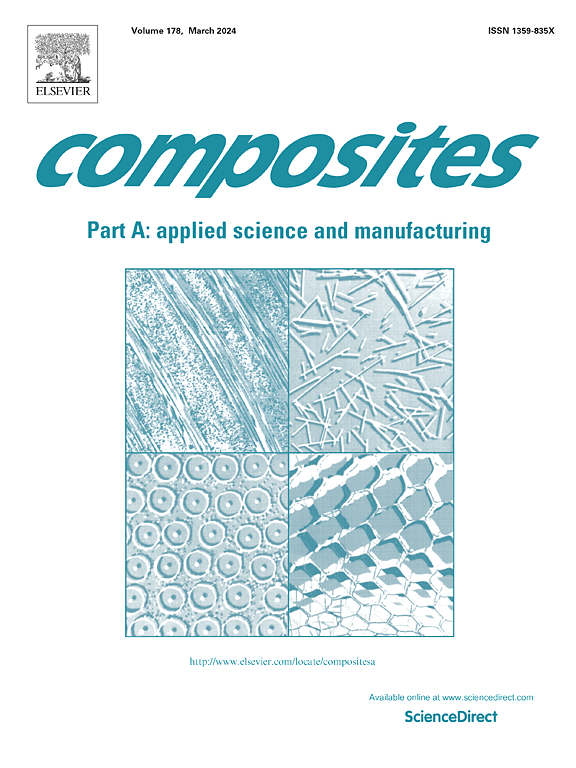Dual-engineered heat transfer pathways via ice-templating and hot-pressing for enhanced anisotropic thermal conductivity
IF 8.1
2区 材料科学
Q1 ENGINEERING, MANUFACTURING
Composites Part A: Applied Science and Manufacturing
Pub Date : 2025-05-09
DOI:10.1016/j.compositesa.2025.109023
引用次数: 0
Abstract
The ability to dissipate accumulated heat in integrated circuits determines the performance, safety, and service life of electronic devices. The regulation of orderly heat transfer pathways in composites is a breakthrough to improve the heat dissipation performance. Herein, the heat transfer property of PI-based composites along the horizontal direction was realized by twice regulation of ice-templating and hot-pressing on the transfer pathways composed of boron nitride-coated silver wires (AgNWs@BN-NH2). The in-plane thermal conductivity (4.14 W m−1 K−1) of nearly 15 times greater than the through-plane thermal conductivity (0.28 W m−1 K−1) manifested the anisotropic heat dissipation capacity of the AgNWs@BN-20/PI10. The heat transfer behavior of composites under pressure was further analyzed by finite element simulation. The change of the pressure value mapped in the model structure indicated that the secondary regulation achieved the optimal horizontal heat transfer effect. Due to the insulating and flame-retardant nature of BN-NH2, AgNWs@BN-20/PI10 exhibited volume resistivity of over 1014 Ω, limited oxygen index of ∼ 38 %, and peak heat release rate of less than 20 W g−1. This strategy offers a promising idea for the development of multifunctional polymer-based thermal management materials with directional heat transfer performance in the electronic applications.

双工程传热途径通过冰模板和热压增强各向异性导热性
集成电路散热能力决定了电子设备的性能、安全性和使用寿命。复合材料有序传热路径的调控是提高复合材料散热性能的突破口。本文通过冰模板和热压两次调节氮化硼银丝组成的传递路径(AgNWs@BN-NH2)来实现pi基复合材料沿水平方向的传热性能。平面内导热系数(4.14 W m−1 K−1)是平面内导热系数(0.28 W m−1 K−1)的近15倍,体现了AgNWs@BN-20/PI10的各向异性散热能力。通过有限元模拟进一步分析了复合材料在压力作用下的传热行为。模型结构中压力值的变化表明,二次调节达到了最佳的水平换热效果。由于BN-NH2的绝缘性和阻燃性,AgNWs@BN-20/PI10的体积电阻率超过1014 Ω,极限氧指数为~ 38%,峰值放热率小于20 W g−1。该策略为电子应用中具有定向传热性能的多功能聚合物基热管理材料的开发提供了一个有希望的思路。
本文章由计算机程序翻译,如有差异,请以英文原文为准。
求助全文
约1分钟内获得全文
求助全文
来源期刊

Composites Part A: Applied Science and Manufacturing
工程技术-材料科学:复合
CiteScore
15.20
自引率
5.70%
发文量
492
审稿时长
30 days
期刊介绍:
Composites Part A: Applied Science and Manufacturing is a comprehensive journal that publishes original research papers, review articles, case studies, short communications, and letters covering various aspects of composite materials science and technology. This includes fibrous and particulate reinforcements in polymeric, metallic, and ceramic matrices, as well as 'natural' composites like wood and biological materials. The journal addresses topics such as properties, design, and manufacture of reinforcing fibers and particles, novel architectures and concepts, multifunctional composites, advancements in fabrication and processing, manufacturing science, process modeling, experimental mechanics, microstructural characterization, interfaces, prediction and measurement of mechanical, physical, and chemical behavior, and performance in service. Additionally, articles on economic and commercial aspects, design, and case studies are welcomed. All submissions undergo rigorous peer review to ensure they contribute significantly and innovatively, maintaining high standards for content and presentation. The editorial team aims to expedite the review process for prompt publication.
 求助内容:
求助内容: 应助结果提醒方式:
应助结果提醒方式:


